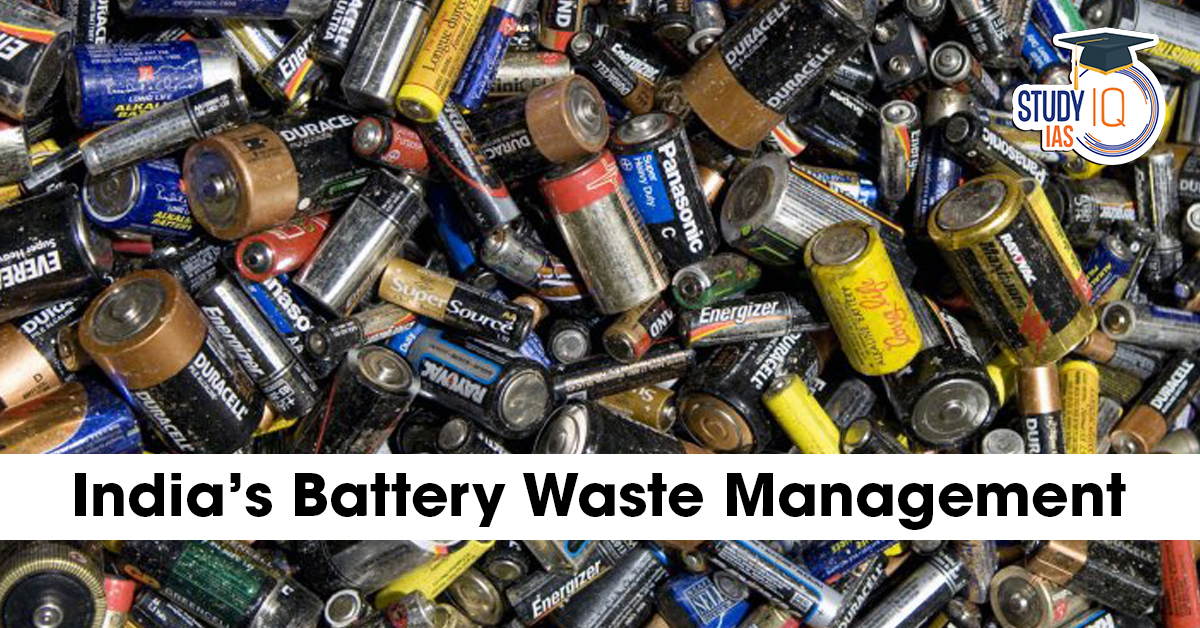Table of Contents
Context: India’s rapid EV and renewable growth is creating surging battery waste, making robust, fairly priced recycling and enforcement essential for environmental security and sustainable economic development.
India’s Battery Waste Management: Current Trends in India
- Rising Demand: Lithium battery demand is projected to increase from 4 GWh in 2023 to 139 GWh by 2035.
- Green Energy Push: India’s Net Zero target by 2070 and the expansion of renewable energy (especially battery energy storage systems or BESS) are key drivers.
- E-waste Generation: Lithium batteries accounted for 7,00,000 tonnes of the 6 million metric tonnes of e-waste generated in 2022.
Challenges Arising from EV Batteries
- Environmental Risks: Improper disposal causes hazardous materials (like heavy metals and chemicals) to leak into soil and water.
- The growing volume of battery waste poses a long-term ecological threat.
- Inadequate Recycling Infrastructure: Lack of a robust recycling framework to manage battery waste sustainably.
- High recycling costs due to requirements of advanced technology, safe logistics, and skilled labour.
- Low EPR Floor Price: Current Extended Producer Responsibility (EPR) floor prices are too low, making legitimate recycling financially unsustainable.
- Encourages fraudulent recyclers who issue fake certificates or dump waste, as seen in India’s plastic waste sector.
- Corporate Non-compliance: Some large producers avoid compliance in developing countries like India, though they follow strict norms in developed nations.
- Loss of Valuable Resources: Poor recycling leads to wastage of valuable minerals like lithium, cobalt, and nickel, increasing India’s import dependency.
- Potential $1 billion foreign exchange loss by 2030 due to inadequate recycling.
| Government Initiatives on Battery Waste |
Battery Waste Management Rules, 2022 (BWMR):
|
Solutions
- Recalibrate EPR Floor Price: Set a fair and globally comparable EPR floor price that covers– Collection, Safe transport, Advanced recycling methods, Material recovery.
- Avoid underpricing — e.g., the UK mandates ₹600/kg, India’s proposal is less than one-fourth of that.
- Strengthen Enforcement: Digitise the tracking of EPR certificates.
- Introduce strong audit systems.
- Impose strict penalties for non-compliance and fraud.
- Formalise Informal Sector: Train and integrate informal recyclers into the formal economy.
- Provide regulatory and technical support to improve recycling standards.
- Foster Industry Dialogue: Encourage collaboration between policymakers, recyclers, and industry to design a viable, sustainable EPR pricing model.
- Ensure No Consumer Burden: Highlight that consumers won’t face price hikes since manufacturers have not passed on the benefits of falling global metal prices.
Conclusion
The rise of EVs in India is inevitable and essential for decarbonisation. But without sustainable battery waste management, especially recycling, India risks serious environmental degradation, economic loss, and a setback to its circular economy goals. A revised EPR framework, industry accountability, and integration of informal sectors can turn this crisis into an opportunity for green growth.


 Bonnet Macaques: Habitat, Features, Beha...
Bonnet Macaques: Habitat, Features, Beha...
 Periyar Tiger Reserve, Map, Flora, Fauna...
Periyar Tiger Reserve, Map, Flora, Fauna...
 Project Cheetah in India, Objectives, Ch...
Project Cheetah in India, Objectives, Ch...

























